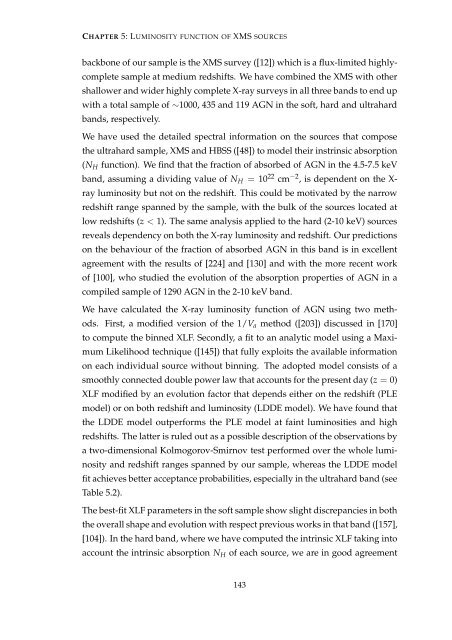pdf - SRON
pdf - SRON
pdf - SRON
Create successful ePaper yourself
Turn your PDF publications into a flip-book with our unique Google optimized e-Paper software.
CHAPTER 5: LUMINOSITY FUNCTION OF XMS SOURCES<br />
backbone of our sample is the XMS survey ([12]) which is a flux-limited highlycomplete<br />
sample at medium redshifts. We have combined the XMS with other<br />
shallower and wider highly complete X-ray surveys in all three bands to end up<br />
with a total sample of ∼1000, 435 and 119 AGN in the soft, hard and ultrahard<br />
bands, respectively.<br />
We have used the detailed spectral information on the sources that compose<br />
the ultrahard sample, XMS and HBSS ([48]) to model their instrinsic absorption<br />
(N H function). We find that the fraction of absorbed of AGN in the 4.5-7.5 keV<br />
band, assuming a dividing value of N H = 10 22 cm −2 , is dependent on the X-<br />
ray luminosity but not on the redshift. This could be motivated by the narrow<br />
redshift range spanned by the sample, with the bulk of the sources located at<br />
low redshifts (z < 1). The same analysis applied to the hard (2-10 keV) sources<br />
reveals dependency on both the X-ray luminosity and redshift. Our predictions<br />
on the behaviour of the fraction of absorbed AGN in this band is in excellent<br />
agreement with the results of [224] and [130] and with the more recent work<br />
of [100], who studied the evolution of the absorption properties of AGN in a<br />
compiled sample of 1290 AGN in the 2-10 keV band.<br />
We have calculated the X-ray luminosity function of AGN using two methods.<br />
First, a modified version of the 1/V a method ([203]) discussed in [170]<br />
to compute the binned XLF. Secondly, a fit to an analytic model using a Maximum<br />
Likelihood technique ([145]) that fully exploits the available information<br />
on each individual source without binning. The adopted model consists of a<br />
smoothly connected double power law that accounts for the present day (z = 0)<br />
XLF modified by an evolution factor that depends either on the redshift (PLE<br />
model) or on both redshift and luminosity (LDDE model). We have found that<br />
the LDDE model outperforms the PLE model at faint luminosities and high<br />
redshifts. The latter is ruled out as a possible description of the observations by<br />
a two-dimensional Kolmogorov-Smirnov test performed over the whole luminosity<br />
and redshift ranges spanned by our sample, whereas the LDDE model<br />
fit achieves better acceptance probabilities, especially in the ultrahard band (see<br />
Table 5.2).<br />
The best-fit XLF parameters in the soft sample show slight discrepancies in both<br />
the overall shape and evolution with respect previous works in that band ([157],<br />
[104]). In the hard band, where we have computed the intrinsic XLF taking into<br />
account the intrinsic absorption N H of each source, we are in good agreement<br />
143
















